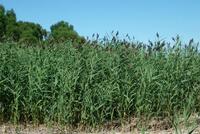Invasive Phragmites
Invasive phragmites (Common reed) –Phragmites austrilis
Where did phragmites come from?
- Invasive phragmites is native to Europe
- Invasive European strains were likely introduced during the 1800’s in ship ballast water
What does phragmites look like?
- Invasive phragmites is a tall, perennial grass that can grow 15 feet or more in height
- Stems are light tan in color and hallow
- Leaves are blue green in color, flat and wide
- Flower heads are dense, fluffy, and gray or purple in color
Why is phragmites a problem?
- Invasive phragmites is a fast-growing plant that forms dense stands that consume available growing space and push out native plants that are vital to birds, fish, and wildlife
- Invasive phragmites degrades wetland and wildlife habitats with dense growth, thus reducing critical resources for birds and other wildlife
- Dense stands impede the movement of boaters, fish, and wildlife
- Large populations alter hydrology, dry up wetlands, impede water movement, and increase the potential of fire risks
How does phragmites spread?
- Phragmites is spread predominantly through seed dispersal – seeds are dispersed from November through January and each seed head can produce up to 2,000 seeds
- Phragmites can spread to new areas when fragments break off a parent plant and are moved to a new location where they can root. This can happen through natural events such as wind and water
- Humans can also unintentionally disperse seeds via contaminated equipment, gear, or boats
- Invasive phragmites are attracted to disturbed areas, open spaces that are free of competitors can easily be colonized
How do we control phragmites?
- Well-established stands invasive phragmites are difficult to control
- Herbicide treatments containing glyphosate and imazapyr can be used to control and reduce large populations
- Herbicide treatments in conjunction with prescribed fire, mechanical pulling or cutting, and flooding can be used to control phragmites
- Treatments usually need to be repeated annually to control dense stands
- Thoroughly inspect equipment, gear, and boats for loose vegetation and remove
- Never take fish or plants from one lake and put them into another
LINKS:
https://nas.er.usgs.gov/queries/greatlakes/FactSheet.aspx?SpeciesID=2937
https://www.greatlakesphragmites.net/files/LS-FactSheet-1.pdf








